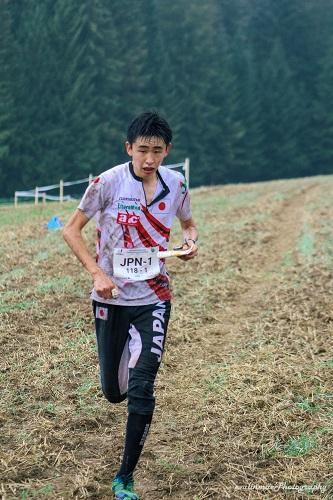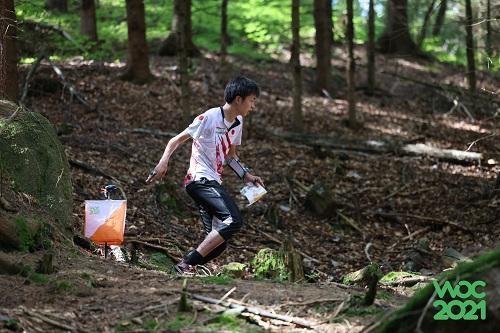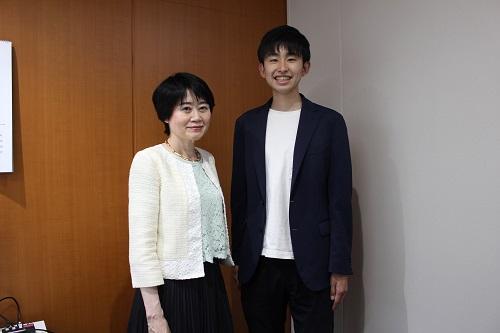Home > Arc Communications Ski Team > An Interview with Hiroki Komaki: Beating the Japanese Record in Orienteering—A Race Through Mountains and Forests
An Interview with Hiroki Komaki: Beating the Japanese Record in Orienteering—A Race Through Mountains and Forests
Introduction
Expectations are growing for rising star Hiroki Komaki, who won the Japan Intercollegiate Orienteering Championships in his senior year of university and also dominated the Japan Orienteering Championships. With his bright personality, he always brings around laughter, and has started working full-time at Arc Communications as a Web director this April.
To beat the previous Japanese record at the World Championships (WOC), Hiroki Komaki will have to make his way through an uncharted path. In this interview, we talked about his commitment as a top orienteer and took an up-close look at the newly graduated employee as he prepares for the upcoming WOC.
(June 2023)
Table of contents
- The “Big Surprise” of the FISU World University Orienteering Championships
- Running Through Mountains on Instinct: That’s the Joy of Orienteering!
- Being Awed by the Beauty of Nature and Going Professional
- Starting with What I Can Do, and Slowly but Surely Closing the Gap
- The Feeling of Omnipotence Brought by Overcoming Nature and Oneself
- Spreading the Joy of Orienteering by Hosting Competitions and Coaching
- Aiming to Become the Highest-ranking Japanese Orienteer—But First, Entering the World’s Top 40
The “Big Surprise” of the FISU World University Orienteering Championships

Ohsato: After Arc Communications (Arc) decided to support you in August 2022, I watched the FISU World University Orienteering Championships on YouTube for the first time. I was so excited to see you place sixth as the first relay runner in the men’s division. Can you tell us your thoughts on that?
Komaki: It played out just how I imagined and it was my most satisfying performance. An almost perfect race.
Ohsato: How was it received?
Komaki: It must’ve been quite a shock that a Japanese orienteer finished sixth and within two minutes of the leading group, because the local commentators called me a “big surprise.” I also remember one of my Swedish competitors, who had won the silver medal in WOC the previous month, come over to the Japanese team and tell us how impressed he was to see me not only catching up with the top group, but also actually leading it. I was so happy and thanks to the competition, grew more confident that I could become as fast as him if I worked hard enough at the world level.
Ohsato: That is wonderful! Now, can you explain a little about orienteering to those who aren’t familiar with it?
Komaki: Orienteering is a sport where you must navigate from one checkpoint to another using a map. The fastest person wins. It was introduced to Japan after the Tokyo 1964 Olympics to encourage citizens to exercise more. Although we did manage to rank 26th at the WOC in the earlier days, we have been struggling ever since, and sadly, we are now way behind top players such as the Nordic countries.
Ohsato: Bearing this is mind, us supporters were astonished by your finishing in the top group of the first runners, within two minutes of Sweden’s 40-minute record. I was deeply moved that we finally had a Japanese orienteer capable of winning an international competition.
Running Through Mountains on Instinct: That’s the Joy of Orienteering!

Ohsato: What led you to this amazing result?
Komaki: It all boils down to building up on my strengths. I believe I have two strong suits, and one of them is my ability to run in forests. The competitions are held in forests, in the nature, with many obstacles along the way: fallen trees, weeds, swamps, rocks and, of course, hills. I’ve been physically training to not be defeated by overseas orienteers, and also been increasing my stamina so I can become faster and stay faster.
My other strength is my self-control. Orienteers are constantly dealing with fear, wondering where they are and whether they’re on the right track. It’s very important to properly navigate under these circumstances to place higher. Thanks to my self-control, I’ve become faster and better at pacing myself and sustaining my stamina.
Ohsato: Orienteering is often described as “a sport of physical strength and intelligence,” isn’t it?
Komaki: Yes. I think that “intelligence” refers to the ability to read maps, how “smart” you are in analyzing the terrain and choosing the best route. To be honest, though, we’re hardly thinking about anything while racing. We’re running through the mountains on instinct, and that’s the fun part. Of course, we think about and try out different things during training, but when competing, I would say that it’s more like our bodies are moving ahead of our brains, rather than really thinking about which way to go.
Being Awed by the Beauty of Nature and Going Professional

Ohsato: You started orienteering in your freshman year of university and it seems like you’ve become a star overnight. Can you tell us about your childhood?
Komaki: I was born in Nagano and loved to play in the wild as a child. In sixth grade, I went trekking, and the moment the adult in charge handed me a map and compass, I just went off sprinting and vanished from sight. The adults got worried and came looking for me, and apparently, they found me in the right spot. I don’t remember much about that event, but I probably haven’t changed much since. (laughs)
When I was in middle and high school, I used to play volleyball, but I couldn’t keep up with the others who were more heavily committed… By the time I entered university, I was tired of sports.
Ohsato: So, what got you into orienteering?
Komaki: Well, it’s your run-of-the-mill type of story, but I heard the exciting words “map,” “forest,” and “running” during the club recruitment week at the University of Tsukuba, and I just couldn’t help myself joining the orienteering club. I had a great time! In the beginning, as you’d expect, I would get lost and wander around or find myself somewhere off the map… It was terrible. But that’s what made it all the more exhilarating when I could correctly navigate a map and cross the finish line.
Ohsato: And what made you decide to pursue orienteering professionally, rather than merely as a hobby?
Komaki: At the time, the University of Tsukuba wasn’t known for having any strong orienteers, and I initially wasn’t participating in many competitions. I was experimenting through trial and error, determined to run faster. My junior year of university was a turning point; one of the members of the Japan national team couldn’t participate at the WOC due to injury, and I got to replace him. I was blown away by the dazzling scenery at my first WOC. The forest definitely was beautiful, but there was also beauty in the unbelievable speed and the gathering of orienteers of the highest level… I realized that this was a world I wanted to take on.
Starting with What I Can Do, and Slowly but Surely Closing the Gap
Ohsato: Having conquered the Japan Intercollegiate Orienteering Championships and the National Championships, you seem to have reached the top without much difficulty. Did you ever face any obstacles?
Komaki: I’ve never faced anything insurmountable. It was more like overcoming small obstacles one at a time. In fact, I’m a realist, and I only want to do what I can do. I set myself a realistically achievable goal thinking, “If I worked this hard, I’ll be able to achieve this.” Then, when I’ve achieved it, I set my next goal, and repeat that sequence on and on.
Ohsato: I believe your last international competition was a huge success, but did you find out any areas of improvement?
Komaki: It was a huge success in the sense that I kept up with the top orienteers and finished within two minutes of them, but I’m facing an even bigger hurdle. At the Swiss Championships held after that competition, the top orienteers managed to finish five minutes quicker than me, on a course that was longer than the one I participated in. Despite my efforts, they’re completely above my level, and I don’t have the slightest idea how to reach the high standards they are setting. It’s no use trying to catch up with them in one big leap, so I have to go step by step, repeating the process of setting a small goal, achieving it, then working towards my next goal… Still, in some way, having such a long way to go makes me feel happy too.
The Feeling of Omnipotence Brought by Overcoming Nature and Oneself

Ohsato: What is it that attracts or captivates you about the top orienteers you have got to compete with?
Komaki: I’m sometimes favorably compared to a moped , but if I’m a moped, then the top orienteers would be something akin to a 4x4 buggy or a wild deer. They run through bushes, over rocks and fallen trees with unbelievable speed even when they lose their balance. At my last competition, I heard a sound coming from the top of a slope, so I turned around to find someone dropping from the air. That person happened to be last year’s world champion. It was really overwhelming!
What I find enthralling as an orienteer is the exhilaration you can feel when running freely through the mountains and being able to go anywhere you want with a single map. I feel omnipotent when I navigate my way towards the goal exactly as I intended: it’s as if I’ve overcome nature and myself.
Ohsato: It’s a pity that we don’t get to see those scenes close up, since the competitions are held on mountains and in forests.
Komaki: Recently, in addition to following races via GPS tracking devices, spectators can now also enjoy watching live footage recorded by auto tracking cameras and drones. You can feel even more immersed if you come to the course, since many venues are designed around the tracks and/or goal. It’s fun to try figuring out which route you would take before watching a race, but you can also enjoy keeping track of the orienteers who’ve got lost. It kind of gives me the chills to think that someone might be watching when I’m lost, though. (laughs)
Spreading the Joy of Orienteering by Hosting Competitions and Coaching

Ohsato: I find it interesting how there’s a unique tradition in the orienteering community, where the orienteers and orienteering-lovers themselves host competitions and training programs. I have even heard there is a saying that goes, “You can only truly understand orienteering once you have helped organize a competition.”
Komaki: I have worked on all these facets as a course planner for the long distance race at the 2022 Japan Intercollegiate Orienteering Championships, from choosing the field and course route to supervising the competition. There actually are worldwide trends when it comes to fields and courses. So, I wanted the contestants in Japan to get a chance to experience these global trends like I did, and I got to try out lots of different things.
Ohsato: So, the competition was an opportunity for everyone to experience the latest international trends, then!
Komaki: In Japan, although many people enjoy orienteering for fun and play it as a college sport, few step into the professional field. Some of the clubs had to shut down during the pandemic, and I can’t help feeling a little hopeless. We are trying to train young orienteers by passing down knowledge through competition hosting and we’ve also been coaching them personally, and we hope this will help the sport to grow.
Ohsato: Yes, it seems like it will take a Japanese athlete to win at an international level for more people to start taking interest and join in the orienteering ranks. That’s why I’m counting on you to reach the top. Athletes can have a long-standing career in orienteering with people in their forties winning, and you are still very young, only 24-years-old, so you still have many opportunities to do this.
Komaki: Yes, I have been thinking about that. Scoring good results as an orienteer would definitely give momentum to orienteering. Plus, I believe it would repay my debt of gratitude to Arc for so warmly taking me in.
Aiming to Become the Highest-ranking Japanese Orienteer—But First, Entering the World’s Top 40

Ohsato: Now, you started working at Arc this year, but what was it that made you choose our company?
Komaki: When I was in my second year of grad school and began thinking of what I wanted to do later, I realized I wanted to pursue orienteering professionally. I was sure that I could become faster and leave better results as an orienteer. You need to keep participating in international competitions if you want to increase your presence globally, and Arc has a sports team and supports athletes. So, that was one of my main reasons.
I was also interested in the position of a Web director. Arc’s mission is: “Putting your business into words, bringing your business to the world.” Since analyses and presentations were my forte, I thought I could make use of my skills and experiences with this job.
Ohsato: Our company doesn’t have any positions specifically for athletes, so you were hired solely based on your skills. In the recruiting process, we hold a workshop where the applicants have to analyze the pros and cons of a website, and your analysis was the best. Not only did we want to support you as an athlete, but we also believed you had great potential as a Web director and, as a result, we decided to hired you. What does your job entail at the moment?
Komaki: I’m working as an assistant on a project with a senior colleague. Since I’ve started working here, I’ve discovered that there’s a wide variety of work to do, from analyzing data, pitching proposals, to designing and coding. I’m looking forward to tackling many kinds of projects and to, one day, lead one as a full-fledged Web director.
Ohsato: Thanks. Lastly, what are your goals as an orienteer?
Komaki: The highest ranking for a Japanese orienteer in WOC was 26th in 1976. My goal is to beat that. I want to be the best orienteer ever.
But I know that’s no easy goal, so, before that, I’m aiming to reach the top 40 in WOC in Switzerland this July. I’ve been practicing at the actual location since last year and increasing my physical training in preparation to race in the best conditions. I’ll continue working towards my goal to reach the top 40 in the Championships and beating the Japanese record. Thank you very much for your support.
Postscript from the Interviewer
Hiroki Komaki was hired through the same process of interviews and presentations as other new graduates. His swift, advanced logical thinking skills were exceptional. We are still searching where his main strengths lie as a business person, as only a few months have gone by since he joined the company, but we are eagerly waiting for him to bloom as an all-rounder, just like he has in orienteering.
We hope he maintains this positive cycle of leveraging his business skills to orienteering and vice versa, so he can go beyond becoming the highest-ranked Japanese orienteer in history.
Afterword
Would you be interested in joining the "Arc Communications Ski Team Fan Club" and supporting Hiroki Komaki?
We are planning fan events such as send-off parties and others during the off-season where fans can talk personally with him. Let's pursue our dream with Hiroki Komaki!
- Fan Club (No annual membership fee)
- Sponsorship Opportunities


